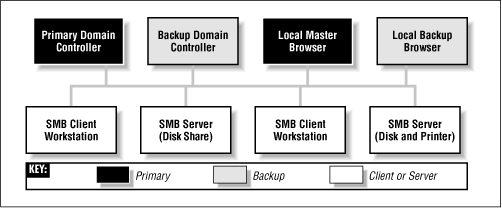As we hinted at the beginning of the chapter, there are actually two types of browsing that you will encounter in an SMB/CIFS network:
Let's look at the first one. On each Windows workgroup (or domain) subnet, one computer has the responsibility of maintaining a list of the machines that are currently accessible through the network. This computer is called the
local master browser, and the list that it maintains is called the
browse list. Machines on a subnet use the browse list in order to cut down on the amount of network traffic generated while browsing. Instead of each computer dynamically polling to determine a list of the currently available machines, the computer can simply query the local master browser to obtain a complete, up-to-date list.
To browse the actual resources on a machine, a user must connect to the specific machine; this information cannot be obtained from the browse list. Browsing the list of resources on a machine can be done by clicking on the machine's icon when it is presented in the Network Neighborhood in Windows 95/98 or NT. As you saw at the opening of the chapter, the machine will respond with a list of shared resources that can be accessed if that user is successfully authenticated.
Each of the servers on a Windows workgroup is required to announce its presence to the local master browser after it has registered a NetBIOS name, and (theoretically) announce that it is leaving the workgroup when it is shut down. It is the local master browser's responsibility to record what the servers have announced. Note that the local master browser is not necessarily the same machine as a NetBIOS name server (NBNS), which we discussed earlier.
WARNING: The Windows Network Neighborhood can behave oddly: until you select a particular machine to browse, the Network Neighborhood window may contain data that is not up-to-date. That means that the Network Neighborhood window can be showing machines that have crashed, or can be missing machines that haven't been noticed yet. Put succinctly, once you've selected a server and connected to it, you can be a lot more confident that the shares and printers really exist on the network.
Unlike the roles you've seen earlier, almost any Windows machine (NT Server, NT Workstation, 98, 95, or Windows 3.1 for Workgroups) can act as a local master browser. As with the domain controller, the local master browser can have one or more
backup browsers on the local subnet that will take over in the event that the local master browser fails or becomes inaccessible. To ensure fluid operation, the local backup browsers will frequently synchronize their browse list with the local master browser. Let's update our Windows domain diagram to include both a local master and local backup browser. The result is shown in
Figure 1.13.

Here is how to calculate the minimum number of backup browsers that will be allocated on a workgroup:
-
If there are between 1 and 32 Windows NT workstations on the network, or between 1 and 16 Windows 95/98 machines on the network, the local master browser allocates one backup browser in addition to the local master browser.
-
If the number of Windows NT workstations falls between 33 and 64, or the number of Windows 95/98 workstations falls between 17 and 32, the local master browser allocates two backup browsers.
-
For each group of 32 NT workstations or 16 Windows 95/98 machines beyond this, the local master browser allocates another backup browser.
There is currently no upper limit on the number of backup browsers that can be allocated by the local master browser.
